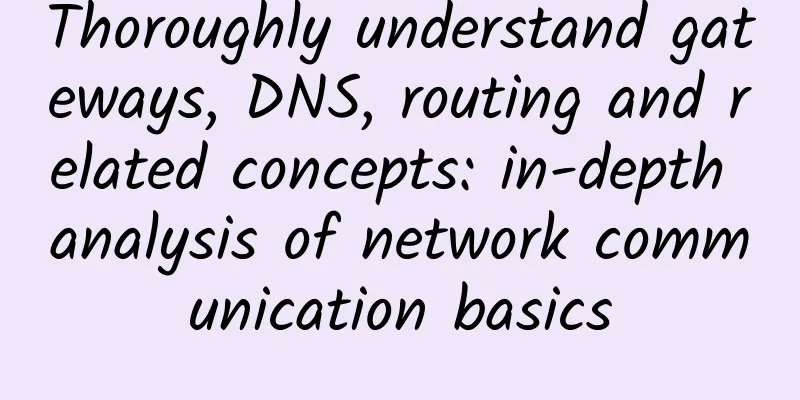Why does 5G need edge computing (MEC)?

|
This article is reprinted from the WeChat public account "Wireless Deep Sea", written by Fei Caicai. Please contact the Wireless Deep Sea public account to reprint this article. Edge computing has been in its infancy since the 4G era. In the 5G era, it has been fully integrated into the network infrastructure, becoming an absolute standard and even a powerful tool for business expansion. So what exactly is edge computing? This article will explore this question. 1. Why do we need edge computing? When it comes to the word "edge", it means the opposite of "central", implying "low level", "unimportant", and "standing aside". In this case, why bother studying "edge computing" when we can just focus on "central computing"? In fact, in the information network, the status of "center" and "periphery" is contrary to our intuitive cognition. The value of the center is to better serve the periphery.
As can be seen from the above figure, the central node of the network is a cloud composed of complex architectures such as access, bearing, switching, and various servers. Its value lies in meeting the various needs of different terminals at the edge of the network: personal communication, game entertainment, smart home, industrial control, etc. The development of technology is driven by these ever-expanding needs of human beings. The three major application scenarios of 5G are a summary of these needs: enhanced mobile broadband (eMBB) is aimed at a series of applications such as high-definition video, massive machine type communication (mMTC) is aimed at massive IoT applications such as smart cities, and ultra-high reliability and low latency communication (uRLLC) is aimed at professional field applications such as industrial control or remote driving. These applications require large bandwidth, low latency, and high computing power, each of which is not easy to implement. One of the most effective methods is to shorten the distance of data transmission and move the service nodes from the center to the edge of the network, closer to the users. In this way, it is much easier to solve bandwidth, latency, and computing power problems. Such a solution is called "edge computing". The most common metaphor for edge computing is the nervous system of an octopus. Its brain, as the central node, only processes 40% of the information and is mainly responsible for overall coordination, while the remaining 60% of the information is processed locally by eight tentacles (equivalent to edge nodes). In other words, octopuses can use their "legs" to think and solve problems on the spot! This flexible and efficient way of processing information has made this invertebrate the pinnacle of intelligence. Edge computing can be said to carry the dream of connecting everything in the 5G era. 2. What is MEC? The 4G and 5G we use in our daily lives belong to mobile communications. Edge computing under mobile networks is naturally called "Mobile Edge Computing", abbreviated as MEC. The concept of MEC originated from a computing platform called Cloudlet developed by Carnegie Mellon University in 2009. This platform delegates functions from cloud servers to edge servers to reduce bandwidth and latency, and is also known as "small cloud". In 2014, the European Telecommunications Standards Institute (ETSI) formally defined the basic concepts of MEC and established a MEC specification working group to initiate relevant standardization work. In 2016, ETSI expanded the concept of MEC to Multi-access Edge Computing, and promoted edge computing applications in mobile cellular networks to other wireless access methods such as Wi-Fi. Driven by ETSI, 3GPP and other standardization organizations have also invested in MEC standard research. Currently, MEC has evolved into one of the important technologies of 5G mobile communication systems. To understand MEC, you first need to understand the four basic concepts involved in MEC: cloud, edge, network, and end. △ Cloud, edge, network, and end form a coordinated organic whole Cloud: Cloud computing and the infrastructure and resources used to support cloud computing, also known as the cloud, are the central nodes for providing services. Edge: Edge, also known as edge computing node, the protagonist of this article, the service node closest to the terminal. Network: The network between the cloud and the edge, and between the edge and the user, an unsung but very important underlying worker. End: Also known as terminal, it is the object of cloud, edge, and network services, including mobile phones, tablets, TVs and all other devices that can connect to the Internet. It is located at the outermost edge of the network and is a consumer of various data. It has also become a producer of content (such as short videos, live broadcasts, etc.). If we use the octopus metaphor again, the "cloud" is like the brain, the "edge" is like the tentacles, the "network" is like the muscles connecting the brain and the tentacles, and the "end" is the food that the octopus wants to catch. The cloud, edge, network and end work together to form the organism of the MEC system, allowing information to flow faster and better. 3. How to deploy MEC? Currently, there are two main types of MEC players in the 5G era: Internet manufacturers and telecom operators. They have different resources, so the edge computing solutions they launch are naturally different. First, let’s take a look at the 5G and MEC converged architecture defined by ETSI. △ The most critical network element of the 5G core network: UPF (User Plane Function) is the link between the 5G core network and MEC, and can provide functions such as data diversion and traffic statistics. As shown in the figure above, on the left is the 5G network, including the core network (including AMF, SMF, PCF and other control plane network elements, as well as the user plane network element UPF), access network (RAN) and terminal (UE). On the right is MEC, including the MEC platform, management and orchestration domain, and multiple APPs that provide services. The connection point between 5G network and MEC is UPF. The full name of this network element is User Plane Function. As the name suggests, it processes the user plane functions of the core network. All data must be forwarded by UPF before it can flow to the external network. In other words, the MEC device responsible for edge computing must be connected behind the UPF network element of the 5G core network. The core network design of 5G is very flexible. In order to reduce the detour of data transmission, the UPF is generally deployed lower than the control plane network element. This is called UPF sinking. For example, China Mobile's core network is divided into eight regions across the country, each of which manages several provinces. However, only control plane network elements are deployed in the computer rooms of these regions, and UPF is deployed down to the provincial centers, and even to cities, districts and counties to facilitate local data digestion. Such an architecture provides conditions for the deployment of MEC close to the edge of the network. For operators, the entire network belongs to them, so the location of deploying MEC is very flexible. Adding MEC functions on the basis of edge UPF to form an edge-integrated enhanced UPF is the simplest solution. Depending on the size of the service area and personalized needs, MEC can be located in the same data center as the core network (4 in the figure below), or located at an aggregation node together with the sinking UPF (3 in the figure below), or integrated with UPF in a transmission node (2 in the figure below), or even merged with the base station (1 in the figure below), close to the user. 1. MEC, UPF and base stations are integrated 2. MEC and the downlink UPF are integrated together in a certain transmission node 3. MEC and the sinking UPF are located at the aggregation node 4. MEC and core network are deployed in the same data center For Internet manufacturers, although they are also actively promoting edge computing, since they do not have the network, they can only support MEC by connecting with the operator's UPF. As shown in the figure below, the edge computing platform of Internet manufacturers needs to be connected to the UPF of each operator, and then connected to the base stations of different operators through UPF, so as to deliver services to each user. △ The edge computing platform of Internet manufacturers needs to be connected to the operator's UPF, using the operator's network as a transmission pipeline Therefore, it can be said that Internet manufacturers have strong "cloud" capabilities, and they support "edge" (MEC) by expanding capabilities from "cloud" to "network"; while operators have full control over the "network", so supporting "edge" is a natural thing, but they need to enhance the capabilities of the "cloud". With the support of MEC, cloud computing power is transferred downwards and terminal computing power is transferred upwards, thus forming a convergence point at the edge computing node that takes into account latency, cost, and computing power. This is the core value of MEC. In addition, the industrial park network also has the needs of data security and intranet access. MEC can serve as a bridge between operators and enterprise intranets, so that intranet data does not leave the park and local traffic is digested locally. △ MEC and UPF can be combined to perform flexible data diversion. Intranet data goes directly through the intranet channel, and private data does not leave the park; extranet data can also go directly to the Internet, running in parallel without any delay. In the 5G era, 2B services centered on industry applications and enhanced 2C services have put forward higher requirements on the network. The demand for high bandwidth, low latency, and high computing power continues to stimulate the faster development of MEC. MEC, a seedling that sprouted in the 4G era, has high hopes for the three major scenarios in the 5G era. Such a seed player with a good foundation will surely grow into a towering tree in the near future and fully empower 5G networks. Well, that’s all for this issue. I hope it will be helpful to you. |
<<: China Telecom's 5G base stations have covered more than 300 cities across the country
Recommend
iWebFusion: Dedicated servers from $49/month, 10Gbps bandwidth servers from $149/month, Los Angeles/North Carolina data centers
iWebFusion (also known as iWFHosting) is a well-e...
How will the two major operators' competition to upgrade IPv6 affect me?
On May 21, at the 2018 Global Next Generation Int...
Apple's in-house modem solution is a huge challenge, but the rewards are huge if it succeeds
Apple's move to develop its own wireless comm...
Global IoT connection technology market forecast by type in 2025
As the number of global IoT deployments continues...
The number of domestic 4G users has reached 1.29 billion, with a penetration rate of 80.7%.
Yesterday, the Ministry of Industry and Informati...
Huawei: Adhering to basic innovation and consolidating the foundation is the key to the flourishing of new infrastructure
On September 23, the "New Infrastructure New...
Report: 5G will become one of the most influential technologies from 2020 to 2025
On October 26, foreign media reported that accord...
Understand how HTTPS works
HTTPS, also known as HTTP over TLS. The predecess...
6G is coming, how will the business change?
The next generation (6G) transmission technology ...
AT&T suspends 3G network and offers free entry-level 4G LTE smartphones
According to Zhongguancun Online, US telecommunic...
The three major operators have completed the deployment of IMS network interconnection and 2G/3G network withdrawal has been accelerated
Recently, the three major operators completed the...
Why is the 400-MHz spectrum ideal for critical communications?
The 400 MHz spectrum, with its long range, excell...
Bacloud: 15% off KVM VPS, 25% off dedicated servers, 10TB hard drive server starting at $28.96/month
Bacloud is a Lithuanian hosting company founded i...
The trend of HTTPS and SSH from the growth history of Dongdong
Dongdong wants to visit the xx website, and the u...
Top 10 edge computing vendors to watch
Due to advances in the Internet of Things (IoT) a...









